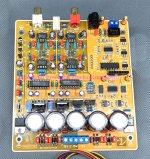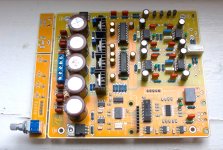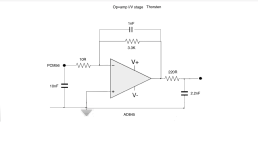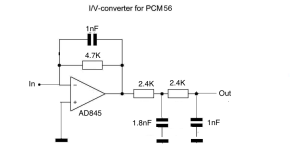Here is a presentation of my excellent inexpensive Finnish DACs: https://www.diyaudio.com/community/threads/dac-gallery.166807/post-8006804
I'm pleased to see @bohrok talking about an actual DAC. Thanks.
Returning to the subject of Chinese DACs, they are not just the current SMSL/Topping types. There are several legacy multibit boards available that you can add power supplies and cases to, and in most instances a USB/SPDIF converter. I use a PCM56 board that I'm happy with after modifying the I/V stage and using an AD797. There's still a lot of mileage in using these legacy chips, especially the PCM56 which isn't too scarce or expensive. I've posted on this a few times in different threads.
Returning to the subject of Chinese DACs, they are not just the current SMSL/Topping types. There are several legacy multibit boards available that you can add power supplies and cases to, and in most instances a USB/SPDIF converter. I use a PCM56 board that I'm happy with after modifying the I/V stage and using an AD797. There's still a lot of mileage in using these legacy chips, especially the PCM56 which isn't too scarce or expensive. I've posted on this a few times in different threads.
Please post some link here.I've posted on this a few times in different threads.
Half right. Any PSS jitter shows up as a distortion spur (which is NOT caused by an assumed slightly curved analog transfer function). OTOH, Random noise jitter does not show up at all as J-Test is normally used. The random noise jitter will only show up in spectral line noise skirts and or in very slight signal-correlated changes in noise floor (slight, because the noise power is distributed over multiple FFT bins, which does NOT necessarily mean its effects are inaudible).It won't as clock jitter manifest itself as distortion on the converted side / analog domain. This we already have measurements for.
Last edited:
Some of the "noise" and some of the IMD products show up in the noise skirts around spectral lines. It is not measured at ASR. Bohrok2610 has shown how to measure this effect, but only non-quantitatively.
Please see: https://www.diyaudio.com/community/threads/phase-noise-in-ds-dacs.387862/post-7063038
Since the measurement is non-quantitative it can't be ranked in the same way SINAD can be ranked. Therefore it is ignored by some people who only understand simple ranking numbers.
Also, errors in the ADC contribute to total errors in the dataset acquired by the ADC. Moreover, for standard measurements such as spectral plots, phase information is discarded so that only half of the information in the acquired FFT data is shown and used. However, it is well known that phase is not necessarily inaudible to humans at frequencies less than 1kHz or 1.5kHz.
In addition, the distinction between distortion and noise is based only on how a spectral plot looks to the human eye/brain. Only PSS signals show up as test tones or as "distortion." A distortion process that is non-PSS will only show up as noise, or as some mix of distortion+noise power components, despite it not necessarily actually being random. For one example, a sine wave sweep across the audio band that is in time with the acquisition time of the FFT will look exactly like noise even though its not noise at all.
So, in total what you see in a spectral plot is of half of the information coming out of the at least slightly distorted ADC process. Obviously, that's not everything there is.
Please see: https://www.diyaudio.com/community/threads/phase-noise-in-ds-dacs.387862/post-7063038
Since the measurement is non-quantitative it can't be ranked in the same way SINAD can be ranked. Therefore it is ignored by some people who only understand simple ranking numbers.
Also, errors in the ADC contribute to total errors in the dataset acquired by the ADC. Moreover, for standard measurements such as spectral plots, phase information is discarded so that only half of the information in the acquired FFT data is shown and used. However, it is well known that phase is not necessarily inaudible to humans at frequencies less than 1kHz or 1.5kHz.
In addition, the distinction between distortion and noise is based only on how a spectral plot looks to the human eye/brain. Only PSS signals show up as test tones or as "distortion." A distortion process that is non-PSS will only show up as noise, or as some mix of distortion+noise power components, despite it not necessarily actually being random. For one example, a sine wave sweep across the audio band that is in time with the acquisition time of the FFT will look exactly like noise even though its not noise at all.
So, in total what you see in a spectral plot is of half of the information coming out of the at least slightly distorted ADC process. Obviously, that's not everything there is.
Last edited:
How do one measure something "non-quantitatively"? A measure is per definition a quantity. What does this mean?
//
//
According to Scott Wurcer, a scope shot of a waveform is a measurement. Measurements are not limited to DVMs that produce only a numerical output.
If you had a digital scope then you could get a number for the amplitude of each sample point, but how will you make sense out of those quantities to evaluate the waveshape when its of a non-PSS signal?
If you had a digital scope then you could get a number for the amplitude of each sample point, but how will you make sense out of those quantities to evaluate the waveshape when its of a non-PSS signal?
If you look carefully how it is build, what it costs and then have a look at other devices you will notice such as it is a low budget device big time. It is the food at some cheap sleazy restaurant that turns out to be one of the better meals you ever had in your life.
You guys simply had the luck ...
If these guys bring out an Ultra 2 with the suggested improvements DIY external stereo DAC projects for normal home audio probably will be history. Maybe they already are.
Well, it your fault that you brought it up, until then, I wasn't paying attention to WiiM, I was trying to fix the issues I had with software.
If you watch out, you can find them on sale on Amazon. Ignore Aliexpress, I keep seeing them there but based on my one experience those are fake sales.
Using them as bridges to the DACs, so their DACs are not crucial...
There is another company that might beat them to it...
If one can't quantify, its not a measuremnt, it's a painting.According to Scott Wurcer, a scope shot of a waveform is a measurement. Measurements are not limited to DVMs that produce only a numerical output.
If you had a digital scope then you could get a number for the amplitude of each sample point, but how will you make sense out of those quantities to evaluate the waveshape when its of a non-PSS signal?
//
Incorrect. A digital scope shot is a set of measurements. It can be gotten out of the scope in CSV or a similar format and FFTs run on it. It can be graphed, analyzed, etc., just like a series of any other kind of measurements. For an analog scope you can use the graticule to read out time and amplitude values too. So its a measurement as well.
But talk about paintings, then maybe you are referring to spectral plots? Or a phase noise plot? They are not measurements?
Besides, I trust Scott Wurcer (RIP) a lot more than I trust your judgement on this issue.
But talk about paintings, then maybe you are referring to spectral plots? Or a phase noise plot? They are not measurements?
Besides, I trust Scott Wurcer (RIP) a lot more than I trust your judgement on this issue.
Last edited:
Please post some link here.
Post #649. Also.....
I want to build one or two fairly simple multi-bit DACs with cheap and available legacy chips, which right now looks like PCM56 or AD1865. All the TDA1541 and PCM63 type stuff has got rare and expensive now.
So point me towards some PCBs or built boards that can be used with PCM56 or AS1865. There seem to be quite a few on AliExpress and I'd welcome advice on which are good ones to buy. Input could be SPDIF or a I2S board.
I can build with tubes so could add a tube output stage and I can build power supplies. But useless with SMDs, that's not possible so a built board would be best...
So point me towards some PCBs or built boards that can be used with PCM56 or AS1865. There seem to be quite a few on AliExpress and I'd welcome advice on which are good ones to buy. Input could be SPDIF or a I2S board.
I can build with tubes so could add a tube output stage and I can build power supplies. But useless with SMDs, that's not possible so a built board would be best...
- andyjevans
- Replies: 28
- Forum: Digital Line Level
A digital scope shot is a set of measurements. It can be gotten out of the scope in CSV or a similar format and FFTs run on it. It can be graphed, analyzed, etc
If you had a digital scope then you could get a number for the amplitude of each sample point, but how will you make sense out of those quantities to evaluate the waveshape when its of a non-PSS signal?
🙃
If you want to discuss these things you need to start to be much more precise with your models, language and used definitions - as now, it's pointless. I'm sure it all makes sense to yourself.
//
As soon as they start improving their DACs and clocks the price goes up. See how previous market leaders Eversolo DMP streamers progressed …Using them as bridges to the DACs, so their DACs are not crucial...
DAC part looks pretty straightforward to improve but for the A98 core unit getting proper audio clocks in requires possibly an entirely new design. Of course for those with good external DACs/Clocks nothing of these new models matters🙂
Attachments
Last edited:
I think there are two different Fs ones in the actual product, just promotional material or simply to confuse the ‘enemies’😁
@acko
May I ask how much effect your clocks have on dac chips such as ES9039xxx? I know what the clocks can do for Marcel's RTZ dac, but I expect that's not the only application.
One reason I ask is because some dac datasheets have a bullet point for good clock jitter tolerance. Seems like maybe the tolerance is only for some of jitter's possible effects.
Thanks,
Mark
May I ask how much effect your clocks have on dac chips such as ES9039xxx? I know what the clocks can do for Marcel's RTZ dac, but I expect that's not the only application.
One reason I ask is because some dac datasheets have a bullet point for good clock jitter tolerance. Seems like maybe the tolerance is only for some of jitter's possible effects.
Thanks,
Mark
Hi Mark, I in the process of building up the 9039 DAC so yes I will test them with OCXOs also and compare it with other types like what you did with Marcels RTZ board. Will be very interesting to see 🙂
We do agree on that."Cues" are forwarded as part of the electrical signal - I hope at least we agree om that.
However, cues are affected by two things not normally measured in the electrical signals: (1) random noise jitter, which can blur out the perceived size of instruments in space ("perceived size" referring to a percentage of the distance between the speakers). If the perceived lateral dimension of a violin bow rubbing on a string is as wide as 50% of the distance between the speakers then something is probably wrong with the cue getting blurred out spatially. And (2) correlated noise, which has become embedded into the audio signal. When a low level signal reverberating in a room naturally fades, eventually it will fade out into below audibility. However the signal can just disappear into correlated noise (which cannot be clearly heard as the noise is buried in with the audio signal so that it goes up and down with the audio signal level just below where the noise could be accurately heard for what it is, but the noise's effect on perception of the music signal can still be be heard) which makes musical reverberation fade out too soon. In that case depth cues are distorted because the ratio of direct to reverberant sound has been changed by the noise.
While the above may seem arbitrary, it describes what observed to happen out in the field, where field-expedient methods are being used to make observations.
So, best as we can tell at this point we need some new and better objective tests. We need tests for random noise jitter, for correlated noise, and for dynamic phase differences between channels (plus maybe some more factors not yet included in the model). They are part of the electrical signal for each channel, and part of the electrical signal represented by the difference between the left and right channel electrical signals. IOW, the information is not just contained in each electrical signal, but also in their differences from each other.
OTOH, what we can measure now is (1) fixed noise floor (that's not enough measurements for the various different types of noise that would be needed for measuring cue reproduction accuracy), and (2) PSS distortion (PSS = Periodic Steady State = one or more repeating fixed level, fixed frequency, and fixed phase sine waves). Distortion which is not by nature PSS will not show up correctly in standard tests, so that's not enough types of distortion measurements as we would need for measuring cue reproduction accuracy.
Okay, so why don't we measure those things already? (1) they were not needed to be measured in the old days when we only had analog amplifiers. Analog amplifiers don't do all the highly nonlinear and non-time invariant things that go on inside a sigma-delta modulator, and or inside an opamp drenched in RF above the opamp's bandwidth. And (2) some of the things are very hard to measure. OTOH, standard measurements are of things that happen to be easy and convenient to measure. Again, standard measurements were developed and were a better fit to the old days before digital audio and before class-D amplifiers.
Last edited:
The SMSL RAW-MDA1 is probably not cheap enough. This is suitably cheap and definitely Chinese. https://www.aliexpress.com/item/1005006324592514.html?spm=a2g0o.productlist.main.35.4eb03e484GF68m&algo_pvid=07e84756-c28d-4fef-b221-00eebb0dbf5a&algo_exp_id=07e84756-c28d-4fef-b221-00eebb0dbf5a-34&pdp_ext_f={"order":"32","eval":"1"}&pdp_npi=4@dis!GBP!5.23!5.23!!!48.64!48.64!@211b813b17469145410798475eb32c!12000036768245205!sea!UK!0!ABX&curPageLogUid=tRx5ih6TlUK8&utparam-url=scene:search|query_from:
Why is this happening, just one day later?
- Home
- Source & Line
- Digital Line Level
- Are there any excellent inexpensive Chinese DACs?





